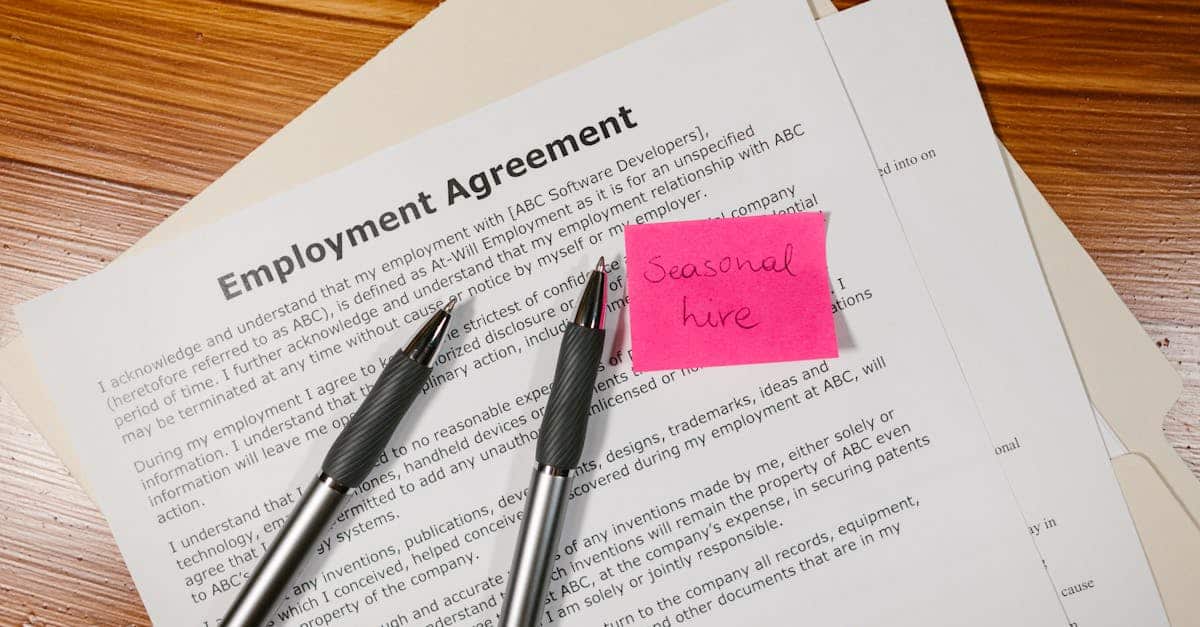
Introduction
Offers should be a speed bump, not a roadblock. Yet many HR, legal, and hiring leaders spend hours reconciling inconsistent clauses, chasing jurisdictional notices, and negotiating redlines — all of which slow hiring and increase compliance risk.
An AI‑powered generator for employee agreements can fix that by combining AI clause libraries, state‑aware compliance, automated negotiation and approval workflows, and e‑sign and audit trails. Below we cover the agreement types and critical clause variations to track, how AI accelerates drafting and reduces errors, how jurisdictional automation and approval workflows protect you, and the templates and integrations that make offer-to-onboarding fast, auditable, and repeatable.
Key employment agreement types and clause variations HR teams need
Types of agreements — HR teams should be familiar with basic forms of employee agreements: fixed‑term (project or seasonal), permanent (indefinite), and contractor/consulting agreements. Each carries different tax, benefits, and IP implications and may require separate clauses for hours, deliverables, and invoicing.
Critical clause variations to include:
- Role and duties: clear job description, reporting lines, and probation period.
- Compensation and benefits: base pay, bonuses, equity, pay schedule, and payroll tax treatment.
- Termination and notice: notice periods, cause vs. without‑cause termination, and garden‑leave options.
- Severance: severance agreement language, release of claims, and conditional payments.
- Restrictive covenants: non‑compete agreement employee clauses, non‑solicit, and reasonableness limits by geography/duration.
- Confidentiality and IP: trade secret protection and invention assignment—link to a ready NDA: employee NDA template.
- Compliance and notices: mandatory state notices, background checks, and immigration compliance.
Practical tips: Treat an employment agreement and an employee contract as overlapping terms in many jurisdictions, but be deliberate about labels because enforceability (e.g., restrictive covenants) varies. Keep a library of an employee contract template and a few employee agreements sample documents to speed tailoring.
How AI clause libraries accelerate drafting and reduce errors
Speed with consistency. AI clause libraries let HR reuse vetted language across employee agreements, reducing time spent drafting and ensuring consistent terms for pay, IP, and confidentiality.
Contextual suggestions: Modern systems surface clause variants based on role, seniority, and local law (e.g., stronger severance language for executives), so drafters get the right wording faster.
Key benefits
- Fewer drafting errors: automated clause selection and inline guidance reduce omissions.
- Risk scoring: AI flags high‑risk clauses (overly broad non‑competes or ambiguous severance triggers).
- Configurable templates: generate an employee agreements template or employment agreement draft from structured inputs (job grade, jurisdiction, remote work).
- Version hygiene: consistent naming and clause IDs make audits and change tracking simpler.
Use these capabilities to standardize hiring documents while still allowing negotiable fields for counteroffers and senior hires.
State‑aware compliance: automating local law clauses and notice requirements
Why state awareness matters: Employment law varies dramatically by state and country. A clause enforceable in one place (e.g., a strict non‑compete) may be void elsewhere. Automating state‑aware language reduces legal exposure.
What automation should do:
- Insert mandatory state notices (pay transparency, sick leave, harassment policy) based on candidate location.
- Adjust restrictive covenant language for jurisdictions that limit or ban non‑competes.
- Apply jurisdictional defaults for notice periods, statutory severance, and reinstatement rights.
Example: For California hires, auto‑swap in California‑specific employment agreement language and notice blocks — see a sample California employment agreement: Employment Agreement (California). For UK hires, surface employee agreements UK rules on termination, tax, and statutory leave.
Automation safeguards: Maintain a legal owner for each jurisdiction, schedule periodic updates tied to regulatory feeds, and log which clause variant was applied to each executed agreement for auditability.
Automated negotiation: redlines, versioning, and approval workflows
Streamline counteroffers: Automated negotiation tools capture redlines, justify changes, and propagate approved language to the master clause library so teams don’t re‑negotiate the same point repeatedly.
Core workflow features
- Real‑time redlines: collaborative editing that tracks suggested edits and comments.
- Role‑based approvals: route exceptions—compensation, equity, severance—to hiring manager, HRBP, and legal in defined sequences.
- Version control: preserve each draft as an immutable snapshot; tag finalized versions to the hire record.
- Audit metadata: capture who approved what, timestamps, and rationale for non‑standard terms.
Negotiation best practices: Use an employee agreement checklist to identify negotiable fields up front (salary, start date, severance, equity). Set clear thresholds for what HR can approve versus what requires legal or exec sign‑off to keep hiring velocity high while controlling risk.
E‑sign, onboarding handoff, and audit trails for hiring velocity
End‑to‑end digitization: E‑sign integration removes friction at offer acceptance and creates a verifiable record of execution. Connect e‑sign to your ATS/HRIS so signed offers auto‑trigger onboarding tasks.
What to automate
- E‑signature capture: legally binding signatures with timestamps and IP audit trails.
- Onboarding handoff: automated task lists for IT access, payroll setup, benefits enrollment, and policy acknowledgements.
- Document retention and audit trails: immutable storage of executed employee agreements and related approvals for compliance and audits.
Practical integrations: Link signed job offers to your offer letter template flow — for example, use a standard job offer letter to trigger e‑sign and then assign the NDA and full employment agreement during onboarding. This reduces time‑to‑hire and prevents lost paperwork during the handoff.
Recommended Formtify templates and how to customize them
Core templates to keep in your library:
- Employment Agreement — California (use for CA hires; swap clauses for other states as needed).
- Job Offer Letter (fast offer generation; link to compensation and conditions).
- Non‑Disclosure Agreement — Employee (attach during offer or onboarding).
How to customize safely:
- Identify mandatory fields: jurisdiction, start date, salary, notice period, reporting manager.
- Flag high‑risk clauses: non‑compete, severance agreement terms, and broad IP assignment should require legal review.
- Localize: swap in state or country‑specific notice blocks and statutory leaves. Use local legal owners to approve variants.
- Test templates: keep an employee agreements sample set for common roles and run periodic compliance reviews.
Checklist before sending: confirm the agreement matches the offer letter, ensure required notices are present, validate approval routing completed, and capture executive sign‑off where necessary. Maintaining a small set of vetted templates and a clear modification policy reduces negotiation friction and legal risk while scaling hiring.
Summary
AI-driven clause libraries, state‑aware compliance, automated negotiation workflows, and integrated e‑signatures let teams draft, approve, and execute offers faster while keeping risk visible and auditable. This kind of document automation helps HR and legal standardize language, prevent jurisdictional errors, and keep hiring velocity high without sacrificing control — especially when managing employee agreements. Ready to streamline your offers and onboarding? Try Formtify: https://formtify.app
FAQs
What is an employee agreement?
An employee agreement is a written contract that defines the working relationship between an employer and an employee, covering duties, compensation, and key terms like confidentiality and IP. It sets expectations for both parties and provides a reference point if disputes arise.
Are employee agreements legally binding?
Generally, yes — a signed employee agreement is legally binding when it meets basic contract elements (offer, acceptance, consideration, and capacity). However, enforceability of specific clauses (for example, non‑competes) can vary by jurisdiction and may require refinement to comply with local law.
What should be included in an employee agreement?
Key elements include the role and duties, compensation and benefits, notice and termination terms, confidentiality and IP assignments, and any restrictive covenants like non‑solicit or non‑compete. You should also include jurisdictional notices, start date, reporting lines, and any probation or severance provisions relevant to the hire.
Can an employer change the terms of an employee agreement?
An employer can change terms only if the agreement permits unilateral modification or the employee consents to an amendment; otherwise, unilateral changes risk breach of contract or constructive dismissal claims. Best practice is to document any changes in a written amendment signed by both parties and route material exceptions through HR and legal approval workflows.
How long should employee agreements be kept?
Retention periods depend on local laws and your company’s compliance policies, but many organizations keep signed agreements and related records for several years (commonly seven or more) to cover statute‑of‑limitations and audit needs. Maintain immutable copies and audit trails for executed agreements to support audits and future disputes.





